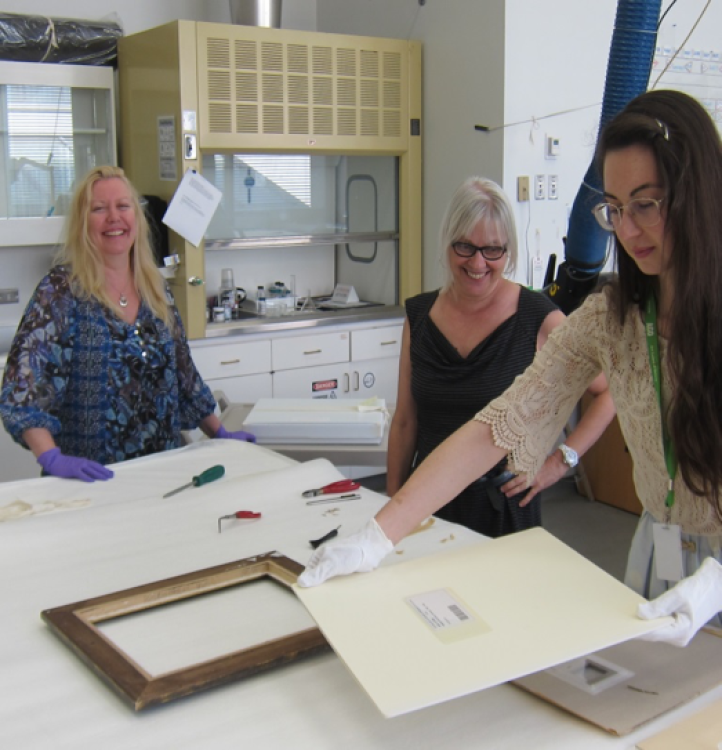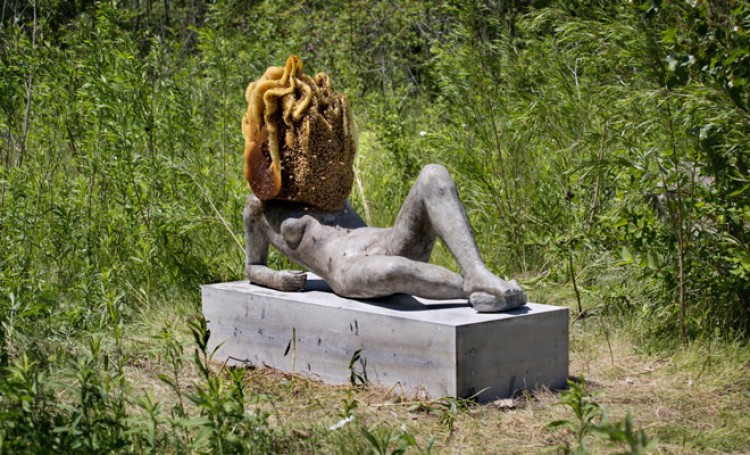Conservation Stories: From Vault to Wall
Sherry Phillips, Conservator, Contemporary Art, reveals the behind-the-scenes process of getting artwork out of the vaults and into the gallery.
Sherry Phillips at work
How does it all begin?
It usually starts with a wish list. A curator will develop an idea for an exhibition and choose artwork or documents they think best explore and explain their concept. That list is then sent to conservators, who evaluate the condition and installation details of each object by heading downstairs... to the vaults!
Descending into "the vaults" sounds incredibly mysterious (and a bit frightening). What's it like down there?
Well, I’ve been asked on many occasions if the AGO vaults resemble the final scene of the film Indiana Jones and the Raiders of the Lost Ark. In some ways, yes they do! We have large rooms filled with racks or shelves that are hung with paintings or stacked with boxes. One of my favourite things about working at the Gallery is spending quiet time in the vaults, just looking at and thinking about the artwork. The layers of concepts and expectations about an artist or artwork are almost absent here. Simply by rolling out screens of paintings, I find myself enjoying the works and making unexpected associations with those works nearby — which offer an interesting blend of themes, colours, eras. We also have vaults filled with large wooden crates, stacked almost ceiling high, containing artwork in various stages of assembly. As the contemporary art conservator, many of the objects I look after are stored as separated component parts. And many of the objects haven’t been assessed in several years.
When assessing if an artwork is ready for display, what sorts of questions are you asking?
There are a range of questions, each of which can easily fit into a typical flow chart. Is it ready to install? If yes, then there is a relatively short path to the gallery space; minor treatment, mount or frame, if any, and scheduling an installation date. If it's not ready to install, the path of processing the artwork to the gallery space becomes much more complicated, and may not happen at all. Does it need treatment to repair or restore? Is the treatment complicated? Do we have the resources and can it be done in a reasonable amount of time, and in time for the exhibition?
Sometimes the original wish list becomes a much more complicated document, with more questions added than answers. One of the interesting features of contemporary art objects is an artists’ exploration of non-standard materials, like plastics or electrical components. These materials may be the primary material or used in combination with other traditional materials, like wood or paint. Electrical components for example may need careful evaluation to ensure they meet parameters laid out by the Ontario Electrical Safety Association. Part of my job is to devise how to meet safety standards while honouring the artist’s original intention.
And what about object research — do you have to check out its history?
Absolutely; and the best way to start is with the object's record. Every object in the collection has an associated permanent record. Some files are surprisingly scant, maybe a page or two, handwritten or typed several decades ago. (Interestingly, the paper files can be fascinating artifacts containing carbon copies and other types of early copying technologies, old letterheads and charismatic signatures.) There may be a brief note about the object's condition when acquired or nothing at all. The internet has proven to be a powerful tool to begin the search for more information , but our library and archives, the artist or estate and even oral history gathered from people who knew the artist or artwork when originally installed, are essential to piece together the history of an undocumented artwork.
In conversation over coffee one day, Greg Humeniuk, Curatorial Assistant, recounted a recent visit with the daughter and granddaughter of a prominent Canadian artist about some artworks that were offered to the AGO from an estate. By speaking with the family, Greg learned about the artist's practice and gained insight into his life and personality — things that aren't generally discussed in existing literature. Oral history is an invaluable source of information that reinforces the complexity and nuanced nature in all of us. Curatorial and conservation practice in turn benefits from greater insight and new avenues of consideration and presentation.
What are some difficulties you've come across when readying artwork for display?
Ensuing conversations with the curators and others members of the installation team may lead to difficult choices — like if we have to substitute one artwork for another already in "exhibition ready" condition. But, at the centre of the discussion is a desire to showcase the best of an artist’s career and the AGO collection. Inclusion on the list may be the first opportunity in a long time to schedule conservation treatment. If one or more artwork must be removed from the wish list however, at the very least we have a much better idea of the current condition, and one or more artworks are added to my long term to-do list.
Signature Partner of the AGO’s Conservation Program
Signature Partner of the AGO’s Conservation Program






